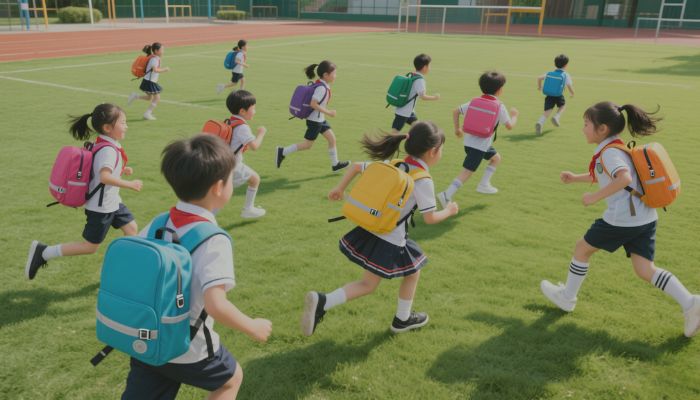Introduction: Why the Right Backpack Matters for Growing Kids
Backpacks are a daily necessity for students—but for growing children, the wrong backpack can lead to long-term posture problems. Unlike adults, kids’ bones are still developing. Add the increasing academic load and digital devices to the mix, and you get a backpack that weighs almost as much as the child wearing it.
Studies suggest that over 60% of school-aged children experience back pain, much of it due to carrying heavy or poorly designed backpacks. That’s where ergonomic school backpacks come in.
But what exactly makes a backpack “ergonomic”? How do you distinguish marketing from function? And what features truly protect your child’s health?
This complete guide breaks down everything you need to know—from medical insights to practical buying tips—so you can choose with confidence.
Section 1: The Science Behind Backpack Ergonomics
To understand the need for ergonomic backpacks, we first need to understand a child’s physiology.
Kids Are Not Small Adults
Children’s spines are more flexible and prone to deformation under uneven load. Their muscles are less developed, and poor posture under weight becomes habitual faster.
When a child carries a poorly balanced or overly heavy backpack, the body compensates by:
-
Leaning forward, stressing the spine
-
Elevating one shoulder higher leads to imbalance
-
Twisting the torso to adjust uneven weight
Over time, these compensations can lead to chronic shoulder strain, muscle tension, spinal curvature, or even early-onset back pain.
What Is an Ergonomic Backpack?
An ergonomic school backpack is designed to:
-
Distribute weight evenly
-
Reduce pressure on the spine and shoulders
-
Align with the child’s center of gravity
-
Encourage upright posture
It’s not about being expensive or “high-tech”—it’s about thoughtful structure and tested support.
What Doctors Recommend
Pediatricians and chiropractors generally recommend:
-
Backpacks should not exceed 10–15% of a child’s body weight
-
Wide, padded, adjustable shoulder straps
-
A padded back with contour support
-
Chest and waist belts for weight distribution
-
Backpacks worn on both shoulders, never one
By following these guidelines, we can prevent injury before it happens, rather than treat it later.
Section 2: Essential Features of a True Ergonomic School Backpack
Now that we know why ergonomics matter, let’s explore what to look for when buying one.
1. Padded and Adjustable Shoulder Straps
Straps should be:
-
Wide (at least 4cm) to avoid cutting into shoulders
-
Curved or S-shaped to follow natural body contours
-
Easily adjustable to fit torso length as kids grow
2. Structured Back Panel
A flat back won’t do. You need:
-
Contoured padding that follows the spine’s natural “S” shape
-
Breathable mesh for ventilation
-
Firm support to prevent the bag from collapsing
3. Chest and Waist Straps
These help by:
-
Keeping the bag stable and centered
-
Transferring weight from the shoulders to the hips
-
Reducing swing while walking or running
4. Lightweight but Durable Materials
A good ergonomic backpack should weigh less than 1.2 kg (2.6 lbs) empty. Materials like:
-
EVA foam (for a structure without weight)
-
Water-resistant nylon
-
Reinforced bottom panels
help keep the pack strong yet manageable.
5. Smart Compartments
Look for:
-
A padded laptop sleeve (for schools requiring tablets)
-
Internal organizers to separate books and supplies
-
A top pocket for quick-access items like sanitizer or bus cards
Balanced load placement = less spinal stress.
Section 3: How to Choose Based on Age & Grade
Different age groups = different backpack needs.
Kindergarten & Early Primary (Ages 4–7)
Backpack features to prioritize:
-
Extra light (under 800g)
-
Small capacity (10–15L)
-
Easy-open zippers
-
Reflective strips for safety
-
Fun but simple designs that encourage usage
Avoid heavy packs with unnecessary features like multiple tech compartments.
Elementary School (Ages 7–11)
Look for:
-
Capacity around 18–22L
-
Reinforced shoulder and back padding
-
Waist and chest clips
-
Side pockets for water bottles
-
Internal compartments for books + lunchbox
This age group often carries more textbooks, so stability matters.
Middle School and Up (Ages 12+)
These students need:
-
20–28L capacity
-
Sturdier frames for more weight
-
Built-in laptop sleeve
-
Durable fabric (e.g., ripstop nylon)
-
Lockable zippers or hidden pockets
Consider the student’s commute as well. For bike riders, opt for reflective features and slim profiles.
Section 4: Maintenance & Wearing Habits – Because Design Isn’t Everything
Even the best backpack can cause problems if worn incorrectly or poorly maintained.
Correct Wearing Habits
-
Always use both shoulder straps
-
Adjust straps so the bag sits 2 inches above the waistline
-
Place heavier items close to the back panel
-
Encourage daily backpack emptying to avoid carrying unnecessary weight
Maintenance Tips
-
Wipe down straps and back panel weekly
-
Check zippers and seams monthly
-
Wash fabric every 2–3 months with mild soap (unless labeled “dry clean only”)
-
Use silica gel packets to prevent interior mildew
What to Avoid
-
Carrying backpacks on one shoulder
-
Hanging backpacks on sharp hooks (can tear straps)
-
Overloading with toys or non-school items
-
Using a bag meant for adults
Section 5: Top Ergonomic Backpack Brands + Buyer’s Checklist
Now, let’s get practical.
Trusted Brands (Global)
-
Deuter: Known for ergonomic designs and vented back panels
-
Ergobag (Germany): Sustainable materials + top-tier spinal support
-
Samsonite Kids: Light, structured, stylish
-
Nike Youth: Sporty options with decent back support
-
Skip Hop Zoo (for toddlers): Lightweight and age-appropriate
Note: Brand ≠ quality. Always verify design specs.
Buyer’s Checklist
| Feature | Check (✓) |
|---|---|
| Total weight under 1.2 kg | |
| Padded S-shaped straps | |
| Contoured back support | |
| Waist and chest straps included | |
| Reflective safety elements | |
| Proper internal compartments | |
| Age-appropriate size (L) | |
| Water-resistant materials | |
| Breathable padding | |
| Return & warranty policy |
Print this list or keep it on your phone while shopping.
Conclusion: One Smart Choice = Years of Healthy Growth
The impact of a backpack might seem small—but over the years, poor habits and poor design can take a toll.
By choosing an ergonomic school backpack tailored to your child’s age, needs, and growth, you’re not just picking a bag. You’re investing in their posture, comfort, and long-term wellness.
So before the next school year starts, do the homework. Let your child try different models. Check weight, structure, and fit.




